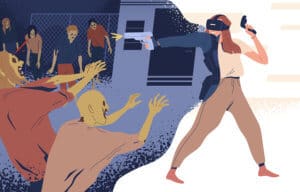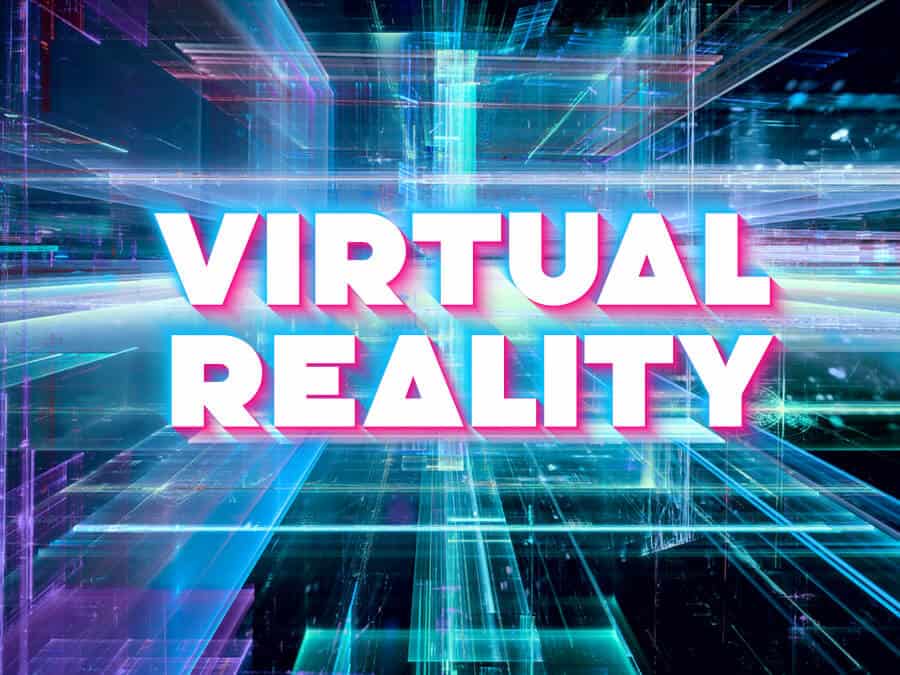Virtual reality is a simulated experience created with technology. Statistics show that nearly one in five US consumers used VR in 2020. In addition to this, 52.1 million in the US alone used VR technology at least once per month this year.
Finally, the research shows that by 2030, there will be 23 million jobs using AR and VR. Especially with remote work and education, the application for virtual reality is more relevant than ever before.
There is no question that it will play an important role in our futures. With over 20 years of experience in 3D animation, visual effects, software production and content creation, Craig Barr.
What are the different types of Virtual Realities?
Today we have varied approaches to Immersive or, ‘Extended’ Realities (XR for short). We have the basics: Virtual Reality (VR) and Augmented Reality (AR). Virtual Reality places an individual in a completely virtual environment, whereas Augmented Reality places virtual objects within the individual’s actual space (“added to” or “augmented” to the user’s experience).
However, there are several variations to each and, in some cases, a blend between different technologies. Virtual Reality can be experienced in a ‘cave’ or ‘dome’ set-up where a user is not wearing a device, yet is still able to experience a to-scale, virtual (often projected) surrounding.
However, the typical use-case is via a Head Mounted Display (HMD). This allows users to experience a completely virtual environment.
As far as the actual VR experience is concerned, we can differentiate these in three ways:
- Collaborative, or an experience with more than one individual sharing the same space, data or content.
- Non-Immersive, or an experience that is guided or presented to the viewer.
- Fully Immersive, where the environment and objects can be manipulated, interacted with, and explored.
Immersing Reality
What potential do animations and immersive realities have in the future?
Modern-day Immersive Reality technology is still very young. Researchers, developers and everyday users are continually finding new and interesting ways to harness virtual experiences for a variety of uses.
Today we are seeing more of a focus on remote work and collaboration and, perhaps, we will see a greater benefit that the overall immersive experience of virtual reality brings to the work and school environments.
Designers are able to collaborate over a product concept model in a virtual space where notations and even changes to the design happen in real-time, together. Entire classrooms can experience a feeling of ‘presence’ with other students from across the globe while learning in a live virtual space.

Immersive realities provide a way to communicate (and understand) concepts and ideas by taking the things we are humanly used to and applying them in a virtual environment that has no bounds.
Exploring virtual places, visualising massive data-sets, designing while experiencing a concept, all of these are examples of where immersive realities may take us.
What role does gamification and animation act in education?
The application of interactive and immersive technologies in an educational context has demonstrated various roles. These include using gamification, animation, or edu-tainment as a means of communicating the core concepts for a lesson or, to enhance the overall understanding of the subject at hand.
This is done by delivering the content in a format that students may find to be a more consumable, efficient method of learning. Studies have shown that the use of gamification in education (and other training and simulation uses) have delivered a higher degree of enjoyment, interest, motivation, enthusiasm, and usability.
Gamifying Learning
How can it enhance online learning?
The use of interactive and immersive technologies for online/remote learning are showing some interesting results. Learners are demonstrating Enhanced Spatial Knowledge, or for that matter, a better understanding of a physical entity/object or construction of an environment.
Experiential Learning is another area that has prompted further research when it comes to Immersive Realities and Online/Remote engagements.
This is the ability to experience concepts, entities, or even entire worlds, that may not be accessible to the learner (think Mars, molecular structures, as examples!).
Another area that has proven useful is overall engagement. Virtual environments provide users the ability to interact and engage with objects and concepts in a much more liberating manner than with traditional media.
Finally, the ability to provide collaborative learning to students in a virtual and immersive sense is something that traditional audio-visual methods cannot. A feeling of presence, scale and community is possible with virtual, online and remote learning environments.
Does Immersive Reality have a future in workplace environments?
All of the different realms that represent Immersive Realities are still quite young and much more research (and trial and error) is still required to truly see the full benefits for everyday adoption in the workplace. However, many industries employ the use of VR and AR to great effect.

There are many great examples of Training and Simulation that provide engaging, compelling, and efficient learning scenarios. Learning the full operation of a complex machine or operating equipment in otherwise dangerous scenarios are examples that are often seen. However, designers are also embracing the ability to work with data in ways that are very tactile, or comfortable in human nature.
Whether the design of a car, a building or a new product, VR and AR allows designers to experience their designs in-scale as they create. There are many use-cases for immersive realities in various industries and we truly are just exploring these different uses.
Looking To The Future
How do you think that VR and Immersive Realities will change our lives in the long run?
We are living in an interesting era that has seen the rise of technology allow people to communicate faster than ever before (ie. smart phones, social media, etc.).
For any technology to become a household, everyday use-case, it needs to be consumer friendly and, most importantly, it needs to have a place – it needs to be useful!
The use of VR and AR in entertainment is certainly the first foray into bringing this technology into our everyday lives.
However, as it becomes smaller, and more consumer-friendly (ie. less expensive) there are certainly many areas that we will see Immersive Realities expand.
Wearable devices (glasses), AR displays in vehicles, interactive smart AR displays in retail, virtual shopping malls, are all examples of other areas that we are beginning to see.
Could immersive reality have a negative impact on how people communicate?
We certainly see the negative impacts of social media, texting or other forms of non in-person communication.
Some of these methods also allow people to hide their identity or act anonymous all together. Immersive Realities and their forms of communication certainly present the same issues and challenges.
However, there are also many benefits that VR and AR bring as methods of communication. A virtual, collaborative means of communication that provides a sense of presence with other individuals in a virtual environment is something that is unique to this technology. At this moment, it certainly does not replace in-person contact.
However it does afford the capabilities of providing a feeling of togetherness with virtual representations (ie. avatars) in a real-world scale scenario.
Of course, as in any anonymous form of communication that various technologies provide, there are ethics and basic rules of respect that should be adhered to!
Utopian World?
How can immersive reality make the world a better place?
Immersive Realities allow individuals (or groups thereof) to experience different scenarios that, otherwise, may be impossible.
For example, exploring remote places, experiencing a different time period, or learning of the customs and traditions of different cultures. Immersive Reality opens up new ways of experiencing and interacting with the past as well as exploring concepts of the future.
Whether it be for science, healthcare or education, Immersive Realities have the potential to allow people to learn by experience. Can this make the world a better place? Perhaps, but like any evolving media, it has a long way to go and, as technology advances to provide faster networks, higher-end graphics processing, more tactile, human-like experiences, Immersive Reality can certainly act as a powerful tool to help us explore and understand our world.
When using VR for education, does quality play an important role?
For Immersive Realities in an educational context, it is imperative that the education curriculum, learning paths and outcomes remain as the key focus.
So, in that sense, quality of education should always remain the top priority, regardless of media. Studies have shown that visual quality, while important in certain areas (such as providing interest to students) is not the most important.
The same principles apply in the world of game design. The playability of the game is absolutely crucial. To this end, having a solid learning experience that produces measurable outcomes is the most important aspect in using Immersive Realities as a teaching method.

Craig has over 20 years of experience in 3D animation, visual effects, software production and content creation for a variety of industries. He brings a unique experience to the presentation and communication of these subjects. In various roles, he has produced hundreds of Technical and Feature videos for software (and hardware) products, and creative workflows.
Craig has also been deemed a “Top-Rated” and “Featured Speaker” presenting at numerous Industry events over the years including: GDC, SIGGRAPH, NAB, and Autodesk University. Craig is currently managing Technical Marketing for Media and Entertainment at NVIDIA.
Catch Craig right here:
LinkedIn: linkedin.com/in/craigwbarr
Personal Website: craigbarr.com
Instagram: instagram.com/polymorphic3d
YouTube: youtube.com/c/CraigBarr_CB3D
Photos: Craig Barr; Shutterstock / Edited by: Martina Advaney
Want to read more about our author Olena? Check this out:
Support us!
All your donations will be used to pay the magazine’s journalists and to support the ongoing costs of maintaining the site.
Share this post
Interested in co-operating with us?
We are open to co-operation from writers and businesses alike. You can reach us on our email at [email protected]/[email protected] and we will get back to you as quick as we can.










